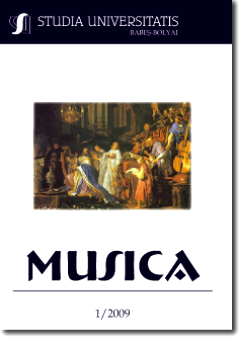CINEMA MUSIC IN THE SILENT MOVIE ERA
Keywords:
film music, silent movie, Lumière, cinema, pianist, organist, skillsAbstract
In the silent movie era, the tendency of using original music specially written for a certain motion picture was abandoned, probably due to its high costs, and the creation and use of musical collages of preexisting cultured and entertainment music was preferred instead.
The cinema musician, in his attempt to follow (R-Receiver) and illustrate (E-Transmitter) by musical accompaniment the cinematographic projections, encountered multiple problems specific to this preoccupation.
The success of this activity would depend on the optimal correlation of a number of general skills (intelligence, creativity, a developed emotional sensitivity, spirit of observation, visual memory etc.) and special artistic skills (rhythmic sense, melodic, harmonic, polyphonic, timbral, and inner hearing etc), on deepening the musical knowledge (both in theory and performance), as well as on certain extramusical skills (knowledge and intuition of the human psychology, psychological intuition, artistic emotion).
An inadequate musical theme, stranger to the action, could easily ruin the effect of the movie, stultifying the hero in his most dramatic moments, causing guffaws from the audience. The producers were quick to understand this danger, and consequently, a lot of movies were distributed together with lists containing suggestions about the musical fragments these were to be accompanied by.
The classic repertoire definitely represented a never-ending source of music in creating the collages. The careful study of successful works was an optimal method of identifying and selecting passages which could be universally applicable in various circumstances, just as the texts of many arias could easily be associated with certain thoughts and emotions.
The music of Verdi, Rossini, Wagner, as well as Tchaikovsky, Liszt or Beethoven was amongst the most frequently quoted in the motion picture theaters. By the diversity of the musical accompaniment, the motion picture theater of the first quarter of the century offered continuous musical education to the large audience.
References
*** : Almanach de Mon Ciné, Paris, 1927.
*** : Musique et Cinéma Muet, Editions de la Réunion des Musées Nationaux, Paris, 1995.
*** : The American Organist, vol.3, no.5, 1920.
Anderson, G.B., Music for Silent Films 1894-1929, Library of Congress, Washington, 1988.
Brown, R.S., Overtones and Undertones: Reading Film Music, ISBN 0-520-08544-2, Univ. of California, Berkeley, 1994.
Davis, R., Complete Guide for Film Scoring, ISBN 0-634-00636-3, Berklee Press, Boston, U.S.A., 1999.
Gagim, I., Psycho-pedagogical and Musicological Foundations of Music Education, a scientific report, Chişinău, 2004.
George, W.T., Playing to Pictures: A Guide for Pianists and Conductors of Motion Picture Theatres, Kinematograph Weekly, London, 1912.
Lang, E. -West. G., Musical Accompaniment of Moving Pictures, The Boston Music Company, Boston, 1920.
Limbacher, J.L., Film Music: from Violins to Video, ISBN 0-8108-0651-7, Scarecrow Press, New Jersey, 1974.
Marks, M.M., Music and the Silent Film, Contexts and Case Studies, 1895-1924, ISBN 0-19-506891-2, Oxford Univ. Press, New York, 1997.
Mesquich, F., Tours de manivelle, Ed. Grasset, Paris, 1933.
Rapeé, E., Encyclopedia of Music for Pictures, Ed. Belwin, New York, 1925.
Rathbun, J.B., Motion Picture Making and Exhibiting, Ed. Thompson, Chicago, 1914.
Sadoul, G., Louis Lumière, Ed. Ştiinţifică, Bucureşti, 1966.
Downloads
Published
How to Cite
Issue
Section
License
Copyright (c) 2009 Studia Universitatis Babeș-Bolyai Musica

This work is licensed under a Creative Commons Attribution-NonCommercial-NoDerivatives 4.0 International License.



